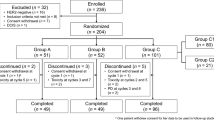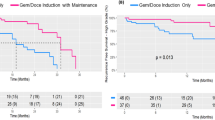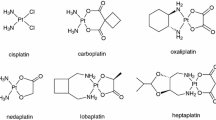Abstract
-
▴ Paclitaxel is a antimicrotubule agent with established antitumour activity in a variety of cancers including breast cancer.
-
▴ The efficacy of intravenous paclitaxel as adjuvant therapy for early breast cancer has been investigated in two large, randomised trials; it was administered sequentially to standard doxorubicin-cyclophosphamide (AC) combination therapy and compared with cycles of AC alone.
-
▴ In both trials, the addition of sequentially administered paclitaxel to the AC regimen significantly improved disease-free survival at 5 years compared with AC alone. In one of the trials, women who received paclitaxel also had a significant improvement in overall 5-year survival time.
-
▴ In randomised trials of neoadjuvant therapy for women with early breast cancer, paclitaxel or paclitaxel-containing regimens showed efficacy in terms of response/remission rates, local breast tumour recurrence and proportion of patients eligible for breast-conserving surgery.
-
▴ The most frequently reported grade 3–4 adverse events with paclitaxel administered sequentially to AC were haematological events (neutropenia, thrombocytopenia, anaemia) and nausea/vomiting.


Similar content being viewed by others
Notes
The use of trade names is for product identification purposes only and does not imply endorsement.
References
Hudis CA. Dose-dense paclitaxel-containing adjuvant therapy for breast cancer. Oncology (Huntingt) 1998 Jan; 12 (1 Suppl. 1): 16–8
Hudis CA. The current state of adjuvant therapy for breast cancer: focus on paclitaxel. Semin Oncol 1999 Feb; 26 (1 Suppl. 2): 1–5
Spencer CM, Faulds D. Paclitaxel; a review of its pharmacodynamic and pharmacokinetic properties and therapeutic potential in the treatment of cancer. Drugs 1994 Nov; 48(5): 704–847
Wiseman LR, Spencer CM. Paclitaxel: an update of its use in the treatment of metastatic breast cancer and ovarian and other gynaecological cancers. Drugs Aging 1998; 12(4): 305–34
Henderson IC, Berry DA, Demetri GD, et al. Improved outcomes from adding sequential paclitaxel but not from escalating doxorubicin dose in an adjuvant chemotherapy regimen for patients with node-positive primary breast cancer. J Clin Oncol 2003 Mar; 21(6): 976–83
Mamounas EP, Bryant J, Lembersky BC, et al. Paclitaxel following doxorubicin/cyclophosphamide as adjuvant chemotherapy for node-positive breast cancer: results from NSABP B-28 [abstract no. 12]. Proc Soc Am Clin Oncol 2003; 22: 4 plus oral presentation 39th Annual Meeting of the American Society of Clinical Oncol; 2003 May 31–Jun 3; Chicago
Citron ML, Berry DA, Cirrincione C, et al. Randomized trial of dose-dense versus conventionally scheduled and sequential versus concurrent combination chemotherapy as postoperative adjuvant treatment of node-positive primary breast cancer: first report of Intergroup Trial C9741/Cancer and Leukemia Group B Trial 9741. J Clin Oncol 2003 Apr 15; 21: 1431–9
Möbus VJ, Untch M, du Bois A, et al. Dose-dense sequential chemotherapy with epirubicin (E), paclitaxel (T) and cyclophosphamide (C) (ETC) is superior to conventional dosed chemotherapy in high-risk breast cancer patients (≥4+LN). First results of an AGO-trial [abstract no. 513]. 40th Annual Meeting of the American Society of Clinical Oncology; 2004 Jun 5–8; New Orleans
Fountzilas G, Papadimitriou C, Aravantinos G, et al. Dose-dense sequential adjuvant chemotherapy with epirubicin, paclitaxel and CMF in high-risk breast cancer. Oncology 2001; 60(3): 214–20
Burtness B, Windsor S, Hsu A, et al. Adjuvant sequential dose dense doxorubicin, paclitaxel and cyclophosphamide (ATC) for high risk breast cancer (BC). Proc Am Soc Clin Oncol 2003; 22: 35
Buzdar AU, Singletary SE, Valero V, et al. Evaluation of paclitaxel in adjuvant chemotherapy for patients with operable breast cancer: preliminary data of a prospective randomized trial. Clin Cancer Res 2002 May; 8(5): 1073–9
Buzdar AU, Singletary SE, Theriault RL, et al. Prospective evaluation of paclitaxel versus combination chemotherapy with fluorouracil, doxorubicin, and cyclophosphamide as neoadjuvant therapy in patients with operable breast cancer. J Clin Oncol 1999 Nov; 17(11): 3412–7
Pouillart P, Fumoleau P, Romieu G, et al. Final results of a phase II randomized, parallel study of doxorubicin/cyclophosphamide (AC) and doxorubicin/Taxol® (paclitaxel) (AT) as neoadjuvant treatment of local-regional breast cancer [abstract no. 275]. Proc Am Soc Clin Oncol 1999; 18: 73
Romieu G, Tubiana-Hulin M, Fumoleau P, et al. A multicenter randomized phase II study of 4 or 6 cycles of adriamycin/ Taxol® (paclitaxel) (AT) as neoadjuvant treatment of breast cancer (BC) [abstract no. 1180]. Ann Oncol 2002; 13 Suppl. 5: 33–34
Malamos N, Kosmas C, Antonopoulos MJ, et al. Prospective randomized study of neoadjuvant chemotherapy (NACT) with paclitaxel/epirubicin (PE) versus fluorouracil/epirubicin/ cyclophosphamide (FEC) in operable stage II–IIIA breast cancer (BC) [abstract no. 105P]. Ann Oncol 1998; 9 Suppl. 4: 22–3
Eiermann W, Sabadell D, Baselga J, et al. European cooperative trial in operable breast cancer (ECTO): no increased risk of local breast tumour recurrence (LBR) as first and only event after primary systemic therapy (PST) [abstract no. 37]. Proc Am Soc Clin Oncol 2003; 22: 10
Bauerfiend IG, Nestle-Kraemling S, Kahlert S, et al. Surgical management of patients following preoperative chemotherapy for primary breast cancer; results from a prospective randomised AGO protocol with dose dense paclitaxel and epirubicin chemotherapy [abstract no. 84]. Proc Am Soc Clin Oncol 2003; 22: 22 plus oral presentation at the 39th Annual Meeting of the American Society Of Clinical Oncology; 2003 May 31–Jun 3; Chicago
Green MC, Buzdar AU, Smith T, et al. Weekly paclitaxel (P) followed by FAC in the neo-adjuvant setting provides improved pathologic complete remission (PCR) rates compared to standard paclitaxel followed by FAC therapy: preliminary results of an ongoing prospective randomised trial [abstract no. 129]. Proc Soc Am Clin Oncol 2001; 20: 33
Gianni L, Baselga J, Eiermann W, et al. First report of the European cooperative trial in operable breast cancer (ECTO): effects of primary systemic therapy (PST) on loco-regional disease [abstract no. 132]. Proc Soc Am Clin Oncol 2002; 21: 34
Taxol® (paclitaxel) injection: prescribing information. Princeton (NJ): Bristol-Myers Squibb Company, 2003
Summary of product characteristics: Taxol. Hounslow, UK: Bristol-Myers Squibb Pharmaceuticals Limited, 2003
Author information
Authors and Affiliations
Corresponding author
Rights and permissions
About this article
Cite this article
Simpson, D., Plosker, G.L. Paclitaxel. Drugs 64, 1839–1847 (2004). https://doi.org/10.2165/00003495-200464160-00008
Published:
Issue Date:
DOI: https://doi.org/10.2165/00003495-200464160-00008




